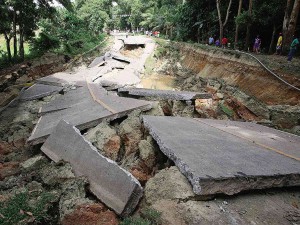DAVAO CITY, Philippines—The Philippine government must take “urgent steps to protect public infrastructure from natural disasters,” the Japan International Cooperation Agency (JICA) said.
In a statement sent out on Wednesday following the devastating Bohol earthquake, JICA had quoted a recent speech by Tatsuo Narafu, its senior advisor on architectural mitigation for disaster, in urging the Philippine government to take steps toward a more resilient infrastructure.
Narafu, speaking before a recent forum on infrastructure safety and resiliency—which was sponsored by the World Bank—said among the steps needed to be taken to improve the resiliency of public infrastructure and facilities to protect it from natural disasters would be a review of the national building code.
He said resilient infrastructure could actually contribute to saving lives.
Narafu said similar actions were taken by the Japanese government following the massive devastation caused by 1995 “Great” Hanshin Awaji earthquake, during which, more than 5,000 people were killed and nearly 35,000 others were injured.
Of the more than 100,000 structures destroyed by the tremor, 38,321 completely collapsed, including a large portion of the Hansin Expressway, which links Kobe and Osaka.
Narafu said more stringent measures were taken by the Japanese government following the 2011 Tohoku earthquake and tsunami that killed 15,883 people. During that earthquake, more than 400,000 structures across 20 prefectures were damaged.
“We recommend a review of the building codes in the Philippines as well as enhancing the capacity of engineers and the private sector to improve the resiliency of public infrastructure,” he said.
Narafu, described by JICA as having “extensive experience in building resiliency initiatives in Japan,” said infrastructure could become resilient through the adoption of better design and construction.
He also said that aside from taking steps toward a more resilient infrastructure, the Philippine government also needed “to assess policies on billboards, water tanks and other materials like beams and columns, which are hazards during strong typhoons and earthquakes.”
JICA has been sharing Japanese resources and expertise to boost infrastructure resiliency in the Philippines for years now.
Currently, the Japanese development agency is conducting a study on how to improve bridges so they could withstand large-scale earthquakes and other natural disasters.
Aside from the Philippines, JICA is also working toward infrastructure resiliency in such Pacific Ring of Fire countries as Indonesia and El Salvador, where earthquakes and tropical cyclones are occurring at regular basis; and Turkey and Armenia—where seismic activities are high.
JICA is considered the world’s largest bilateral aid agency with about $10.3 billion in financial resources and is active in many countries.
Related Story:
Aquino flies to Bohol, Cebu to see damage


